Influence of Bulk Density on Near-Infrared Spectrum Detection of Cement Raw Materials and Compensation Methods
Near-infrared (NIR) spectrum detection technology is used widely, with broad application prospects in detecting the composition of cement raw meal. However, the onsite cement production environment is relatively complex, noting that the output needs to be adjusted continuously according to the production requirements. Furthermore, the sampling volume is changing continuously, affecting the online detection results. This paper examines the influence of sample bulk density on a NIR spectrum detection model of cement raw meal by establishing two different models of calibration set samples. The model I samples have the same bulk density, but the model II samples have a bulk density that changes. After a smoothing preprocessing of the spectral data and band selection, a detection model was established by partial least squares regression. A comparison of the prediction results of the two groups of models revealed a 19.10%, 17.65%, 20.37%, and 27.40% increase in the coefficients of determination (R2) of SiO2, Al2O3, Fe2O3, and CaO, respectively, in model II compared to model I. The experimental results show that the variation of bulk density leads to specific errors in the prediction results of the model.
China has ranked first globally in cement production for many consecutive years (1). The cement industry is a typical processing industry. As the first link in cement production, the quality of cement raw meal will affect the subsequent production links, so it is essential to detect the composition of cement raw meal and to guide its production. Most cement enterprises in China use X-ray fluorescence (XRF) detection and chemical analysis for the offline detection of cement raw meal. This detection method has the disadvantages of a complicated sample preparation process, long detection period, and difficulty in the timely guidance of production. Some enterprises have introduced an online analyzer for cement raw meal elements. Although this detection method allows the real-time online detection of cement raw meal elements, the use of radioactive sources in the detection instrument requires the approval of the relevant regulatory departments, and at the same time, poses particular hazards to the environment and onsite operators (2–4).
As a quantitative analysis method, near-infrared (NIR) spectroscopy has the characteristics of speed, safety, multi-component simultaneous analysis, good repeatability, and no need for sample processing. It has been widely used in industries such as material manufacturing and agriculture (5–8). Several studies have examined the detection of cement raw meal components by NIR spectroscopy. Rong (9) examined the rapid detection of cement raw meal components by NIR spectroscopy, and Zhenfa (10) realized the rapid detection of cement raw meal components using the backward iterative partial least squares–genetic algorithms (BIPLS–GA) method. Hang (11,12) studied the influence of humidity and temperature on the detection results of cement raw meal components. As the output of cement raw meal often changes in an actual production process, the sampling amount will change. There has been no research on the influence of the cement raw meal bulk density on NIR spectrum detection. Therefore, research is needed regarding the influence of sample bulk density on cement raw meal composition detection, and the online detection of the cement raw meal composition.
The intensity of diffuse reflection light will be affected by differences in bulk density, thus affecting the accuracy of NIR spectrum detection. For example, Ortega-Zúñiga (13) examined the influence of the powder density of a drug powder on NIR spectroscopy detection. Based on the volume density of the powder mixture, the active pharmaceutical ingredient (API) modeling method was adopted to study a correction model for NIR spectroscopy detection. Román-Ospino (14) established a calibration model for NIR spectroscopy to predict the grinding density of drug formulations in real-time. Qibing (15) established a PLS regression and discriminant analysis model for the mean values of the short wave NIR spectra and hyperspectral scattering spectra of wheat flour samples, which were used to determine the bulk density and particle size classification of wheat flour samples. This research showed that the different bulk densities of powder affect the detection results of NIR spectroscopy. The output of cement raw meal will change according to the production requirements or raw material reserves, causing some difficulties in realizing the online detection of cement raw meal components. How much impact the bulk density will have on the test results, and whether it can be solved in modeling technology, is an urgent problem that needs to be solved.
In this paper, the NIR spectra of cement raw meal with different bulk densities of the same sample were compared, and the direct influence of the bulk density on the NIR spectra of cement raw meal components was determined. Band selection and PLS regression algorithms were adopted based on the NIR spectrum detection technology. Models were established using samples with different bulk density gradients and samples without bulk density gradients. The prediction effects of the two models were compared. The influence of different bulk densities of cement raw meal on the prediction results of the NIR spectrum detection model is discussed and summarized. The results provide theoretical and technical support for realizing the online detection of cement raw meal components.
Experimental
Instruments and Samples
The instrument test instrument used was the MB3600 Fourier transform NIR spectrometer (ABB Co., Ltd.) with solid diffuse reflection measurement accessories and Horizon MB spectrum acquisition software (ABB), and the ARL Advant’x X-ray fluorescence spectrometer (Thermo Fisher Scientific).
Samples of cement raw materials used in this experiment were obtained from the production line of China’s Shandong Qufu Zhonglian Cement Co., Ltd. XRF fluorescence detection (ARL Advant’x) has been adopted for the detection of cement raw meal components because of the limitations of the production conditions and onsite detection methods. Table I lists the cement raw meal components, and Table II shows the modeling results of raw spectra. It can be seen that the modeling using raw spectral data without density information has poor detection results.
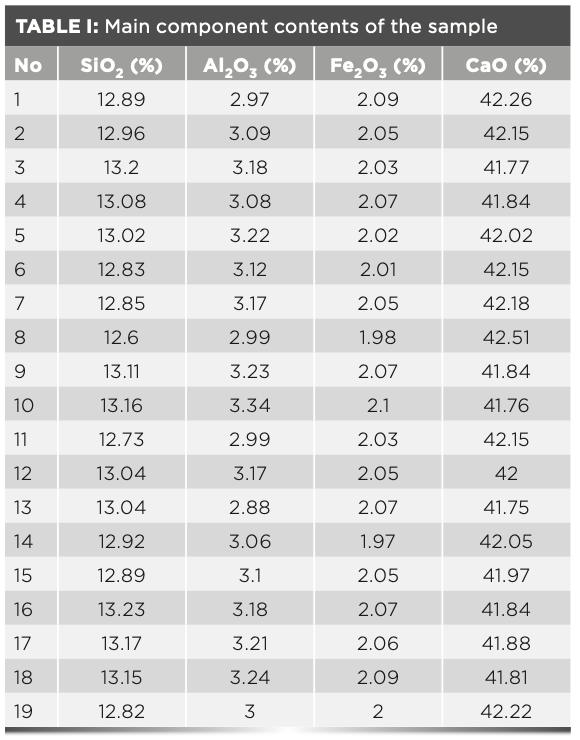

Experimental Method
The NIR spectra of the cement raw meal samples were collected under the following conditions: preheating for 1 h and diffuse reflection sampling using packed and compressed polytetrafluoroethylene as the reference reflectance background. The ambient temperature, humidity, scanning replicates, spectral range, and resolution were 28±1 oC, 40% R.H., 64 replicates, 10,000~4000 cm-1, and 4 cm-1, respectively. The experimental procedure was as follows:
- Step 1: Nineteen cement raw meal samples (100 g each) were divided into 15 calibration set samples, and four verification set samples. The calibration set samples were measured five times to obtain the average spectrum. The 15 spectra were subjected to a spectral pretreatment and band selection, and a model was finally established to obtain model I.
- Step 2: 11 bulk density gradients were made for each of the 15 calibration set samples. The average spectra were detected three times for each bulk density sample, and spectral pretreatment and band selection were performed on the 165 spectra to establish model II. In the experimental process, the compaction sample method was used to increase the compactness of the cement raw meal, thereby increasing the bulk density of the cement raw meal. First, 100 g of cement raw meal samples were normally tested, and 50, 100, 150, 200, 250, 300, 350, 400, 450, and 500 gram weights were then added to the cement raw meal. When the weights were changed each time, the cement raw meal was stirred to loosen, and finally, 11 spectra of the bulk density gradient were obtained.
- Step 3: 11 sample bulk density gradients were made for each of the four samples of the verification set using the method in step 2. The spectra were measured three times for each bulk density gradient, and the 44 spectra were obtained as the verification set. The validation set was input into models I and II, and the prediction results of the two models were compared.
Spectral Pretreatment
Effective pretreatment methods are needed to process the NIR spectrum of cement raw meal to remove noise and establish a mathematical model with a high signal-to-noise ratio (S/N). In this paper, the Savitzky-Golay method was used to process the NIR spectrum. This method can improve the appearance of the spectrum, and reduce the noise interference. The Savitzky-Golay smoothing filtering effect varies with the selection width, and is highly adaptable to different measurement conditions. The parameters of this study were as follows: a window width of 5, a polynomial fitting term of 2, and a derivative order of 1. Figures 1 and 2 show the original spectrogram and preprocessed spectrogram of the same sample under different bulk densities, respectively.
FIGURE 1: Near-infrared spectra of cement raw meal under different bulk densities of the same sample.

FIGURE 2: Near-infrared spectra of cement raw meal with different bulk densities after the Savitzky-Golay pretreatment.
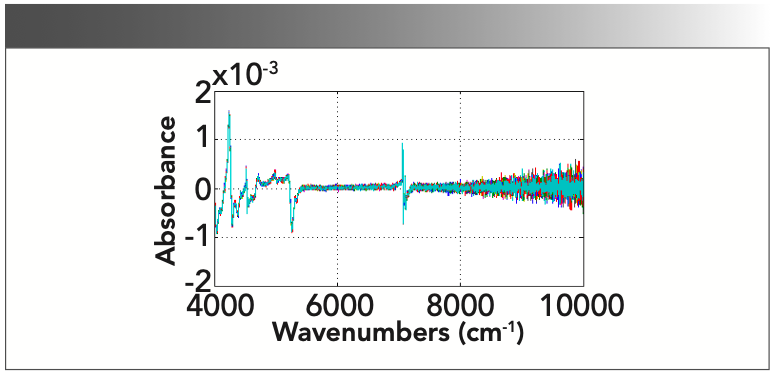
Band Selection
The competitive adaptive reweighted sampling (CARS) method was used to optimize the variables of the NIR spectrum (3113 wavelength points) of the cement raw meal. The SiO2 molecule is used as an example to illustrate the variable screening process, as shown in Figure 3a. The wave selection processes of Al2O3, Fe2O3, and CaO are shown in Figures 3b, 3c, and 3d, respectively; these are similar to that of SiO2 in variable selection. The number of variables decreases slowly from fast to slow with an increasing number of runs. An exponential relationship was observed between the number of runs and the number of variables retained. From the trend change chart of the residual root-mean-squared error of cross-validation (RMSECV) obtained by cross-validation, it can be seen that the residual showed a decreasing trend between 1 and 19 run times, indicating that the variables irrelevant to the sample were eliminated in the screening process. The key variables might be eliminated when increased to more than 19 run times, thus causing the residual to increase. The store corresponding to the regression coefficients path chart was the lowest point of RMSECV, and each curve showed the changing trend of the regression coefficient for each variable with the increase in operation times. Finally, after selecting the wavebands using the CARS method, the NIR spectrum of cement raw meal corresponding to SiO2, Al2O3, Fe2O3, and CaO was reduced from 3,113 wavebands to 180, 243, 209, and 209 wavebands, respectively. Figure 4 show the results for the band selection.
FIGURE 3: Illustrating key variables selection by CARS for each compound: (a) SiO2; (b) Al2O3; (c) Fe2O3; and (d) CaO.
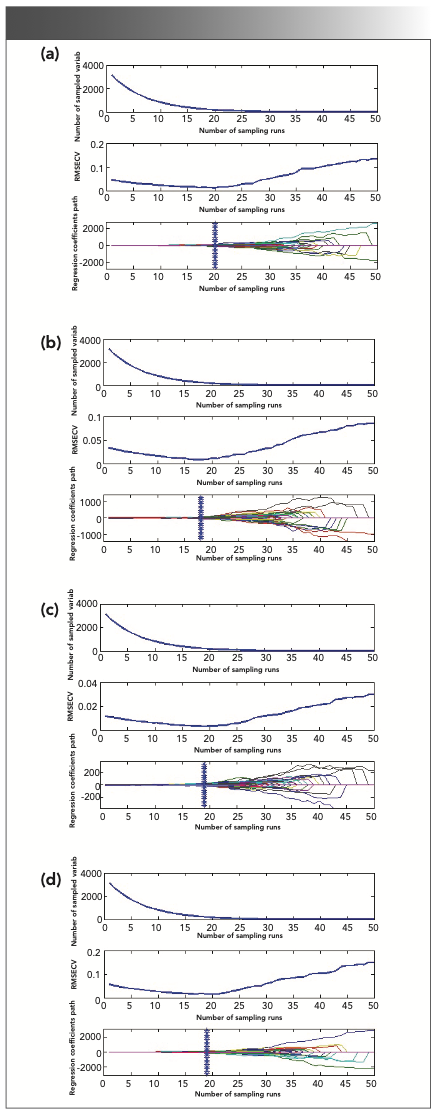
FIGURE 4: Showing band selection results for each compound: (a) SiO2; (b) Al2O3; (c) Fe2O3; and (d) CaO.
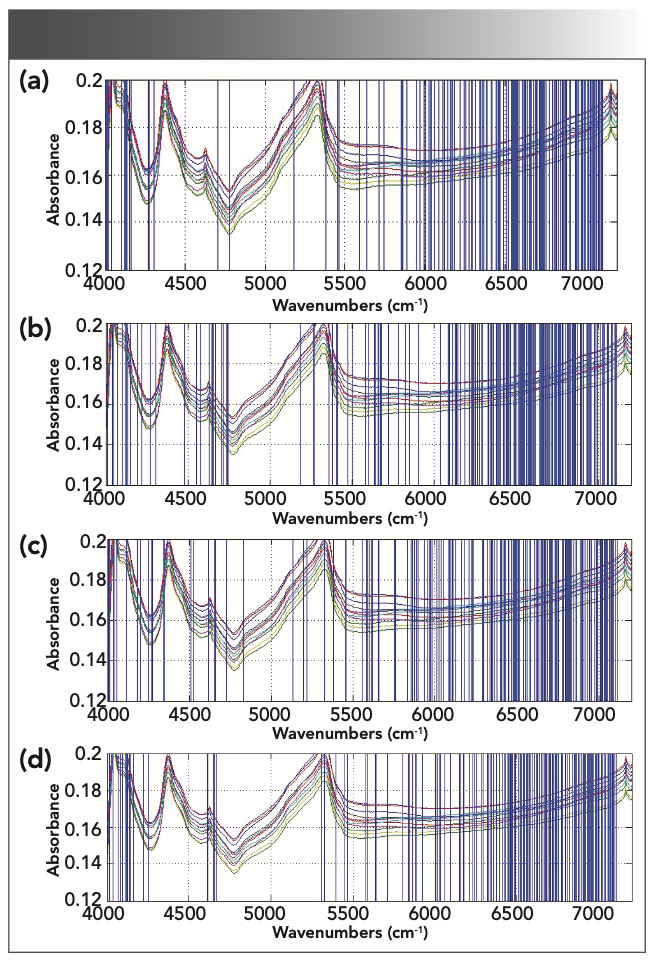
Modeling Method
The NIR spectrum and component content of the cement raw meal were modeled using a partial least squares regression method. The method decomposes the spectrum matrix and the component content matrix while introducing the information of the component content matrix into the spectrum matrix decomposition process. Before calculating a new principal component, the score of the score precomponent content matrix of the spectrum matrix was exchanged. The obtained spectrum principal component was related directly to the component content.
Results and Discussion
In China, most cement plants use the three-rate value as the standard to measure the quality of raw meal. The limestone saturation coefficient KH(%), silicic acid rate SM(%), and aluminum oxygen rate IM(%) are expressed as follows:
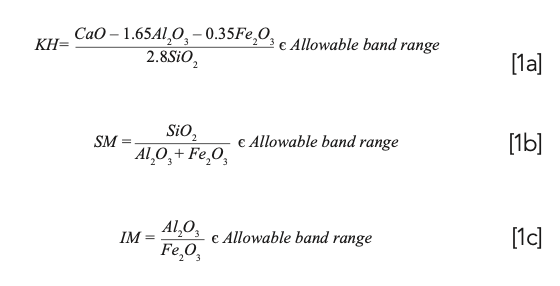
The allowable fluctuation range of the silicic acid rate and the aluminum oxygen rate is 0.1, whereas the allowable fluctuation range of the limestone saturation coefficient was 0.02. Therefore, high accuracy is required to detect the cement raw meal composition, and a high accuracy detection model is of great significance to stabilize the quality of cement raw meal.
The accuracy of the evaluation detection model is judged mainly by the model correlation coefficient (R2), RMSECV, and prediction root mean square error (RMSEP) (16). The closer R2 is to 1, the smaller the RMSEP and the better the detection result of the model. As shown in Table III, the model indices of the two groups of experiments were compared. Model II is superior to model I in terms of the R2 and the RMSEP. The SiO2, Al2O3, and Fe2O3 contents are far less than CaO, and the contents are very low with only slight fluctuations, so the difference in RMESP between models II and I is small. Nevertheless, it is important to improve the accuracy of the cement raw meal composition detection results. The results are consistent with the current results of NIR spectroscopy detection of cement raw meal components (17). By comparing the two groups of models for each component, and the modeling indices R2, RMSECV, and RMSEP were improved after adding the factors influencing the bulk density, and the RMS error RMSEP predicted by model II was reduced by 19.10%, 17.65%, 20.37%, and 27.40% compared to model I, because the bulk density was added in the modeling process, which reduced the influence of the operation error to some extent.
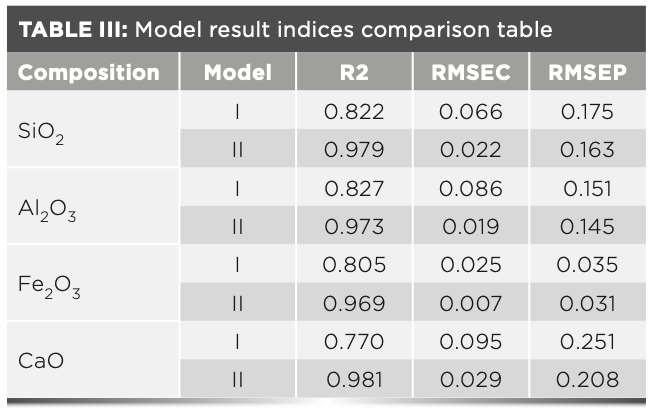
The results showed that the change in bulk density of the same cement raw meal sample would have a specific influence on the prediction results of the model. Adding a cement raw meal sample with a bulk density for modeling can effectively improve the accuracy of the model.
Conclusion
The CARS band selection method and PLS regression modeling method were sampled to study the influence of the bulk density on the prediction effect of the NIR spectral model of cement raw meal. Models I and II were established using the cement raw meal samples without and with a bulk density gradient, respectively. By comparing the prediction ability of the two models for samples with a bulk density, the RMSEP of the SiO2, Al2O3, Fe2O3, and CaO content models in the cement raw meal were reduced by 6.8%, 3.5%, 14.9%, and 20.5%, respectively. The experimental results showed that, because of some differences in the sample bulk density during sampling or sample preparation, the prediction results of the NIR spectroscopy model would be affected to some extent. Modeling with samples with a bulk density gradient can effectively reduce the influence of the sample bulk density on the prediction results, improve detection accuracy, and provide theoretical and technical support for the online detection of the cement raw meal composition.
Funding and Disclosures
Funding
This study was supported by the National Natural Science Foundation of China (No. 61601197) Shandong Provincial of China Key R & D Project (No. 2017CXG0610), the Key Research and Development Plan of Shandong Province of China (No. 2019GSF109018).
Disclosures
The authors declare no conflicts of interest.
References
(1) L. Ai-guang, [EB/OL]. http://www.ccement.com/news/content/695545007577091013.html, 2019-09-27
(2) P. Stutzman and A. Heckert, Adv. Civil Engineer Mater. 3(1), 434–453 (2014).
(3) GB/T 176-2017, “Methods for Chemical Analysis of Cement,” National Standards of the People’s Republic of China.
(4) X. Zhang, D. Cheng, D. Gu, L. Liu, and M. Wang, 2009 4th International Conference on Computer Science Education, 464–468 (2009).
(5) Z. Liu, W. Li, and Z. Wei, Text. Res. J. 90(9–10), 1057–1066 (2020).
(6) A.A. Munawar, Y. Yunus, D. Devianti, and P. Satriyo, Data in Brief 30, 105469 (2020).
(7) L. Weijie, J. Benoit, L. Alexandre, C.M.G.C. Renard, and S. Bureau, Food Chem. 310, 125944 (2020).
(8) R.N.M.J. Páscoa, P.A.L.S. Porto, A.L. Cerdeira, and J.A. Lopes, Talanta 214, 120852 (2020).
(9) R. Hu, L. Xu, W. Liu, et al. Fourier Transform Spectroscopy 40(1), 41–47 (2018).
(10) Y. Zhenfa, X. Hang, Z. Lei, F. Dejun, Z. Faye, J. Mingshun, S. Qingmei, and J. Lei, Spectrochim. Acta, Part A 223, 117327–117335 (2019).
(11) X. Hang, Y. Zhen-fa, Z. Lei, Z. Fa-ye, S. Qing-mei, J. Lei, and J. Mingshun, Spectroscopy and Spectral Analysis 40(3), 867–872 (2020).
(12) X. Hang, Y. Zhen-fa, Z. Lei, Z. Fa-ye, S. Qing-mei, J. Lei, and J. Mingshun, Chin. J. Las. 47(1), 297–303 (2020).
(13) C. Ortega-Zúñiga, C. Pinzón-De la Rosa, A.D. Román-Ospino, A. Serrano-Vargas, R.J. Romañach, and R. Méndez, J. Pharm. Biomed. Anal. 164, 211–222 (2019).
(14) A.D. Román-Ospino, R. Singh, M. Ierapetritou, R. Ramachandran, R. Méndez, C. Ortega-Zuñiga, F.J. Muzzio and R. Romañach, J. Int. J. Pharm. 512(1), 61–74 (2016).
(15) Q. Zhu, Y. Xing, R. Lu, et al., J. Near-infrared Spectrosc. 25(2), 116–126 (2017).
(16) P.S. Sampaio, A. Soares, A. Castannho, et al., Food Chem. 242, 196 (2018).
(17) J.P. Rebouças, J.J.R. Rohwedder, and C. Pasquini, Anal. Chim. Acta 1024, 136–144 (2018).
Bing Huang is with the Key Laboratory of Building Materials Preparation and Testing Technology at the University of Jinan, in Jinan, China. Xiaohong Wang and Ping Jiang are with the School of Electrical Engineering at the University of Jinan, in Jinan, China. Direct correspondence to: cse_jiangp@ujn.edu.cn ●
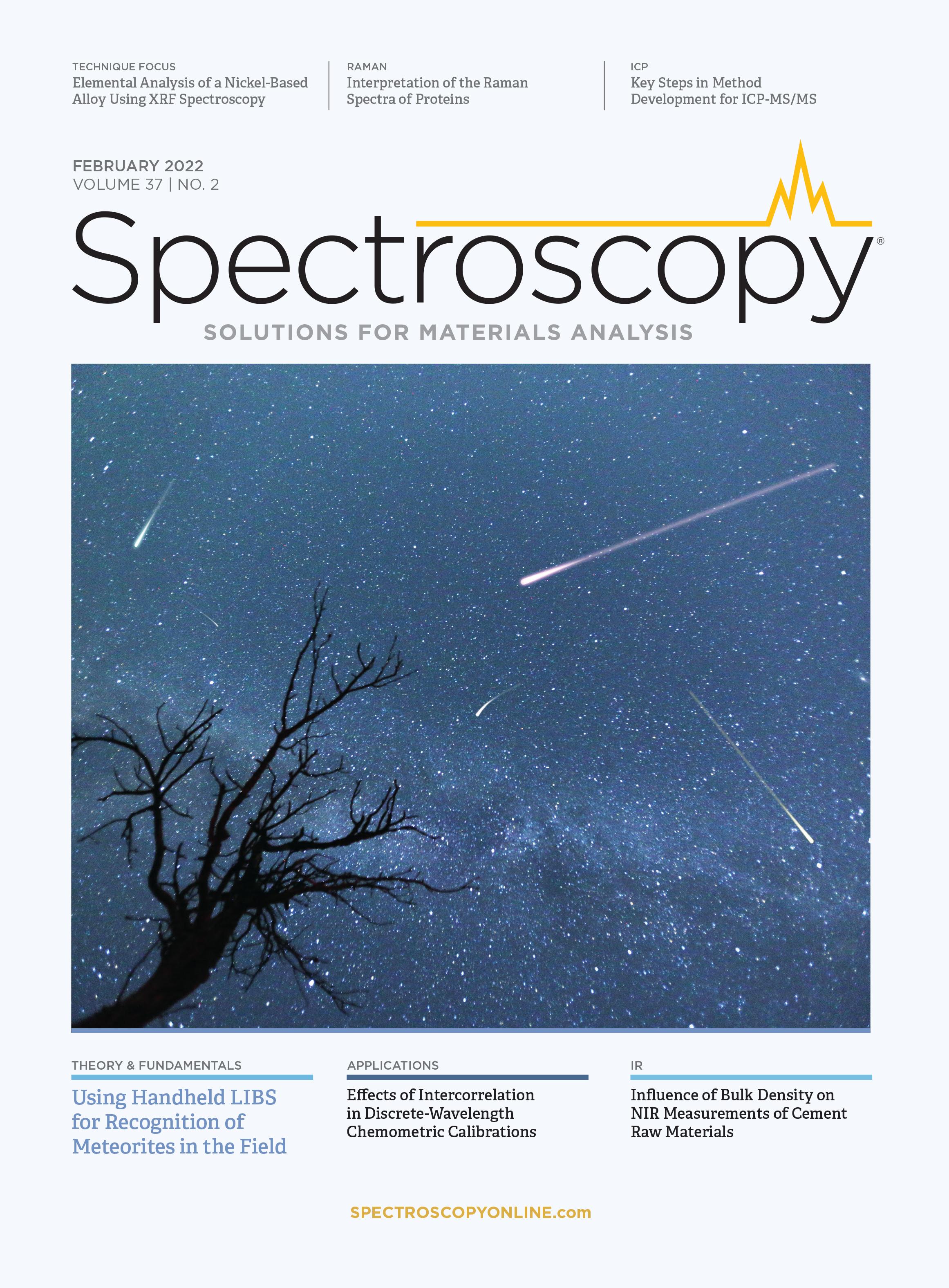
NIR Spectroscopy Explored as Sustainable Approach to Detecting Bovine Mastitis
April 23rd 2025A new study published in Applied Food Research demonstrates that near-infrared spectroscopy (NIRS) can effectively detect subclinical bovine mastitis in milk, offering a fast, non-invasive method to guide targeted antibiotic treatment and support sustainable dairy practices.
New AI Strategy for Mycotoxin Detection in Cereal Grains
April 21st 2025Researchers from Jiangsu University and Zhejiang University of Water Resources and Electric Power have developed a transfer learning approach that significantly enhances the accuracy and adaptability of NIR spectroscopy models for detecting mycotoxins in cereals.
Karl Norris: A Pioneer in Optical Measurements and Near-Infrared Spectroscopy, Part II
April 21st 2025In this two-part "Icons of Spectroscopy" column, executive editor Jerome Workman Jr. details how Karl H. Norris has impacted the analysis of food, agricultural products, and pharmaceuticals over six decades. His pioneering work in optical analysis methods including his development and refinement of near-infrared spectroscopy, has transformed analysis technology. In this Part II article of a two-part series, we summarize Norris’ foundational publications in NIR, his patents, achievements, and legacy.